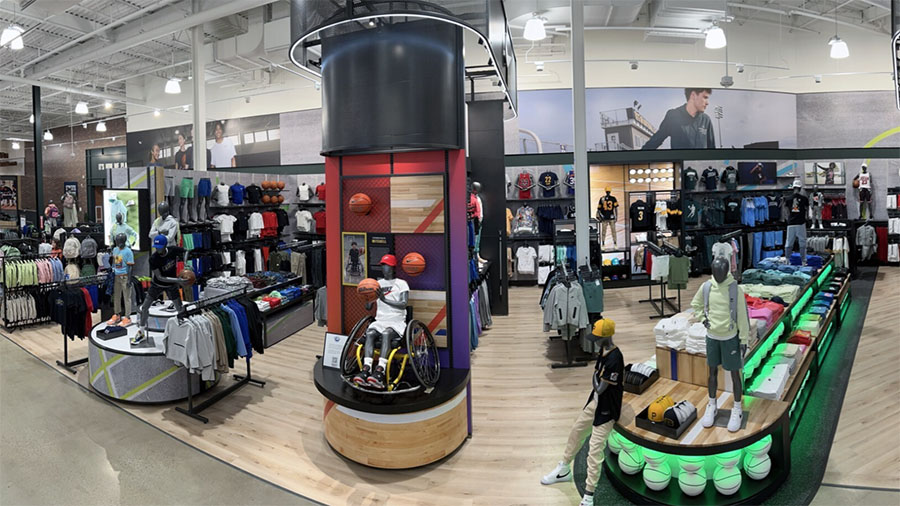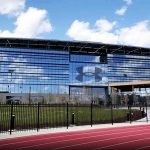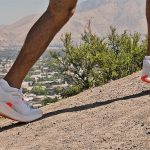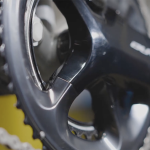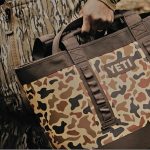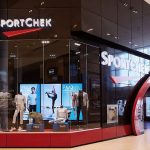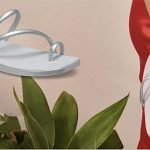Dick’s Sporting Goods beat second-quarter earnings estimates by approximately 13 percent but only raised EPS guidance by roughly one percent for the year, and that had Wall Street analysts scratching their heads and investors paring ownership in DKS shares.
Shortly after the market opened, DKS shares were down nearly 10 percent after the retailer beat top- and bottom-line estimates for the second quarter and raised guidance for the year. The Street apparently wanted more upside and took it out on the company’s stock when it did not arrive.
The argument is based on the logic that if the full-year upside is higher than what was delivered, then investors want to know what is holding them back. A similar situation arose last week after Birkenstock posted a very strong quarter, but company shares took a hit after guidance failed to meet the first-half growth trend line.
Company EVP and CFO Navdeep Gupta addressed the issue head-on during the question segment of the Q2 conference call with analysts.
“We continue to expect 2024 consolidated sales in the range of $13.1 billion to $13.2 billion,” offered Gupta in his prepared remarks. “We now expect full-year comp sales growth in the range of 2.5 percent to 3.5 percent compared to our prior expectation of 2.0 percent to 3.0 percent growth.”
Gupta also said the retailer expects gross margins to expand year-over-year compared to previous expectations for a modest expansion.
“Based on the strength of our business, we are making some strategic investments to drive long-term growth and we now expect SG&A expenses on a non-GAAP basis to de-leverage modestly year-over-year,” the CFO detailed.
“For pre-opening expenses, we expect second-half expenses to be moderately higher than the first half, driven by the timing and mix of our new store openings,” Gupta continued. “The vast majority of this expense will fall into the third quarter.”
DKS now anticipates full-year earnings per diluted share to be in the range of $13.55 to $13.90 compared to prior expectations of $13.35 to $13.75. Gupta said the earnings guidance is based on roughly 83 million average diluted shares outstanding and an effective tax rate of approximately 23 percent.
DKS also expects net capital expenditures of approximately $800 million for the year.
Gupta reminded the call participants that due to the impact of the shifted calendar, reported total sales benefited by approximately $140 million, and EPS had an upside of approximately 45 cents in earnings per diluted share in the first half.
“We expect an offsetting negative impact in the second half of the year,” Gupta added to the conversation. “With the key back-to-school week shifting out of Q3 and into Q2 this year, the vast majority of this offset will happen in the third quarter.”
Gupta said Dick’s estimates the unfavorable impact to Q3 reported total sales to be approximately $105 million, or approximately 35 cents in earnings per diluted share.
“Excluding the 53rd week last year, which added $170 million, or 19 cents in earnings per diluted share, this shift will not impact our full-year results.
On one question in the Q&A session about inventory, Gupta noted that by looking deeper into the updated guidance, it reflects the confidence the company has in its assortment.
“We raised our second half comp expectations modestly and actually raised our merch margin expectations also modestly in the second half,” he said.
Regarding a question on CapEx in the back half, Gupta explained the areas of focus for those expenses.
“We are investing in the core strategy,” he said. “So, things like repositioning our portfolio is one. The technology investments that are allowing us to provide a very differentiated level of service to our athletes when they walk into our store or the technology investment that is making our website so much more functional—those are the core areas of investment that we are leaning into to continue to position our business for 2025 and beyond in a very differentiated way,” Gupta added.
“The other comment that I would add to that is the investment in our SG&A is balanced against the confidence that we have in our total margin expectation,” he explained. “If you look deeper into our guidance, we have raised our total margin expectations for full year and then net that against the SG&A investment. In totality, we actually have taken our operating margin expectations up by 10 basis points compared to our prior guidance,” Gupta continued.
Another analyst questioned the second-half implied comp guidance and asked, given the strength in comp average ticket and the retailer’s engagement with customers, what should investors expect to moderate in the back half of the year? Is it more ticket moderation or transaction moderation?
Gupta responded that the company does not provide guidance at that level of detail and went on to talk boilerplate about how the company feels really confident about its core strategies and product offerings and how excited it is about the back-to-school and holiday seasons.
But the meat of the matter came when the CFO summarized and said in the last answer in the Q&A session.
“The range that you are seeing from a guidance perspective, on a comp basis, is primarily driven by the macroeconomic uncertainties that we wanted to be acknowledging as we provided the guidance today.”
Gupta’s response added weight to an earlier comment he made to an analyst’s question.
“We are expecting positive comps in the second half, both in Q3 and Q4,” the CFO noted. “The only thing the difference between the high end of the range or the low end of the range is balancing the macroeconomic uncertainties that exist, as the consumer continues to be under pressure, and we are balancing our optimism and our confidence in our core strategy against the macroeconomic backdrop.”
So, even the largest sporting goods retailer in the country, which just posted 4.9 percent comp growth in the first half of the year, also has concerns about the consumer. As many others have noted in their earnings calls, they are clearly seeing something at the store level.
In another twist, Gupta called out the voluntary 8-K the company filed last week. “We disclosed that on August 21, we discovered unauthorized third-party access to our information systems. Based on our current knowledge, we do not believe that this incident is material. It did not disrupt our business. Our stores remained open, and our e-commerce sites were functioning throughout,” he explained.
Company president and CEO Lauren Hobart and Gupta focused on the quarter’s results after reviewing the raised guidance.
“Our Q2 results continue to demonstrate how well our long-term strategies are working and the great execution of our team,” Hobart started with her prepared remarks. “Powered by our compelling omni-channel athlete experience, differentiated product assortment, best-in-class teammate experience, and our ability to create deep engagement with the Dick’s brand, we are driving sustained top-line momentum and gaining market share. I am really proud of our team.”
Dick’s Sporting Goods, Inc. posted net sales of $3.47 billion in the fiscal second quarter ended August 3, an increase of 7.8 percent year-over-year (y/y) versus $3.22 billion in fiscal Q2 last year, including the expected benefit from the retail calendar shift of approximately $95 million, or 30 cents in earnings per diluted share, which included a benefit from the calendar shift due to the 53rd week last year of approximately $95 million or $0.30 in earnings per diluted share. Adjusting for the calendar shift, which Dick’s believes provides the clearest view of the business, comps increased 4.5 percent as it continued to gain market share.
Comparable store sales growth came in at 4.5 percent y/y, on top of the 2.0 percent y/y comp store sales growth in the year-ago Q2 period. Hobart said the strong comp was driven by growth in average ticket and in transactions.
“Our strong comps were driven by a 3.5 percent increase in average ticket and a 1 percent increase in transactions,” detailed Gupta. “We saw strength across key categories, led by footwear and athletic apparel.”
Six-month year-to-date comps were up 4.9 percent y/y through August 3.
“We saw more athletes (customers) purchase from us and they spent more each trip compared to the prior year,” Hobart noted. “With growth in sales, gross margin expansion, and SG&A leverage, we achieved an EBT margin of nearly 14 percent and EPS of $4.37, both significantly ahead of last year. At the heart of our strategies is our omnichannel athlete experience. We’re continuing to invest across our digital and store experiences to meet our athletes wherever they are, create confidence and excitement, and get product into their hands faster.”
Hobart said the company continues to be “very pleased” with the performance of House of Sport and the next generation 50,000-square-foot Dick’s stores, which internally they now refer to as their “Field House” concept. “During Q2, we opened four Field House locations and with 17 now open, we look forward to opening nine more locations this year,” she said.
“With House of Sport, we are redefining sports retail and creating very strong engagement with our athletes, our brand partners and communities,” Hobart shared. It’s also driving significant benefits to our real estate partners. We continue to hear from mall operators that our House of Sport locations drive increased traffic, sales per square foot, and occupancy rates for the malls where they operate.”
The CEO said Dick’s opened its 15th House of Sport store and plans to open five more before year-end.
Income Statement Summary
Gross margin was 36.7 percent of sales in the second quarter, a 231 basis point increase compared to the 34.4 percent margin in the year-ago Q2 period. The increase was said to be driven by a higher merchandise margin of 169 basis points and leverage on occupancy costs due to the higher sales. A favorable sales mix and the assortment’s quality drove the merchandise margin increase. Gupta said it also included a lower year-over-year shrink of 83 basis points, as the company anniversaried higher shrinks from 2023 that included an unfavorable true-up based on the physical inventories last year.
Selling, general and administrative (SG&A) expenses were $796.7 million, or 22.9 percent of sales in the quarter compared to $764.8 million, or 23.7 percent of sales, in the year-ago quarter.
Gupta reported that SG&A expenses increased 4.1 percent to $786.3 million on a non-GAAP basis basis and leveraged 78 basis points compared to last year due to the higher sales. The increase in SG&A dollars included higher incentive compensation expense, planned investment in marketing and costs to support sales growth. Pre-opening expenses were reportedly $8.9 million, a decrease of $24 million compared to the prior year, driven by the timing of new store openings.
Operating margin was 13.5 percent of sales in Q2, compared to 9.7 percent of sales in Q2 last year.
Net income was reported at $362.2 million, or $4.37 per diluted share, in the second quarter, compared to $325.9 million, or $2.82 per diluted share, in the corresponding year-ago quarter, representing a 55 percent y/y increase in EPS.
Dick’s Sporting Goods, Inc. ended Q2 with approximately $1.7 billion in cash and cash equivalents and no borrowings on its $1.6 billion unsecured credit facility.
“As a result of our consistent and strong financial performance and commitment to a healthy balance sheet, Moody’s upgraded our credit ratings from Baa3 to Baa2 in early August,” Gupta noted.
Inventory levels at quarter-end increased 11 percent compared to the end of Q2 of last year. “This inventory investment has been a conscious decision to lean into differentiated key items and categories, which are expected to drive our growth into the second half of 2024 and into early 2025,” Gupta noted. “We believe our inventory is clean and well-positioned as we enter into Q3.”
Capital Allocation
Net capital expenditures were $199 million, and DKS paid $89 million in quarterly dividends.
“We also repurchased 252,000 shares of our stock for $49.9 million at an average price of $198.05,” the CFO said.” Thus far this year, we have repurchased a total of $163.6 million of our stock. For the full year, we continue to expect share repurchases of $300 million.”
Image courtesy Dick’s Sporting Goods, Inc.

